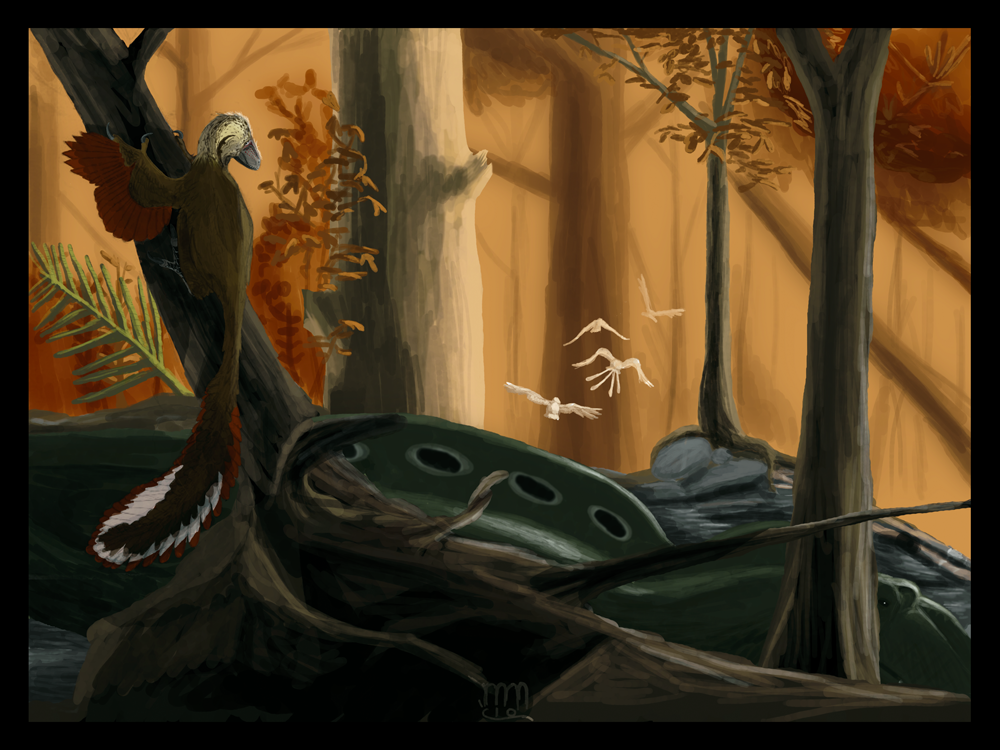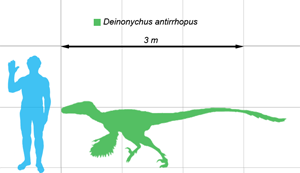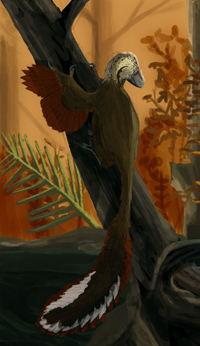home > natural history
Deinonychus antirrhopus
"counterbalancing terrible claw"

click here to buy a print of the original verison of "The Retreat"
Creeping out into a clearing in the forest, a lone ornithomime approaches a Maiasaura nest, which has been left temporarily unguarded. Using its sharp beak, the dinosaur cracks open several of the eggs and devours their contents. Noticing the giant hadrosaurs returning, the ornithomime snatches up one last egg and retreats into the forest. In the safety of the dark, thick foliage, it consumes the last egg, but is startled by a sound from the woods. It is being hunted. Frightened, the swift dinosaur retreats farther into the woods, but it's attackers are already upon it. A Deinonychus pack chases down the ornithomime, digging into it with their deadly sickle claws. Slowed by loss of blood, the ornithomimid falls to the ground, and the Deinonychus feast.
This scene, taken from a short stop-motion film which was later re-used in a special hosted by Christopher Reeve in the late 1980s, is what truly sparked my interest in dinosaurs and solidified my favorite prehistoric creatures: Struthiomimus and Deinonychus. Arguably one of the best known ornithodesmids, Deinonychus was a wolf-sized bird, reaching about 3m (9ft) long including its stiffened, counterbalancing tail. Its remains have been found associated with a Tenontosaurus and other Deinonychus, spawning the belief that these and other ornithodesmid raptors were pack hunters. While there is little evidence to back this up, it is not unlikely.
I've drawn a few renditions of the above scene before (here and here). For my third depiction of Deononychus in its enviroment, I went for a different approach. Rather than the cliche of hunting in a pack (which is only very waekly supported by evidence, it's more likely these dinosaurs mobbed prey in loosley coordinated groups like modern birds and reptiles), I've done a lone Deinonychus fleeing in the lumbering wake of another predatory dinosaur, the carcharodontosaur Acrocanthosaurus. Recent studies have shown that the wing and foot claws of dromaeosaurs were ideal for climbing trees, a behavior probably restricted mainly to juveniles in larger species like D. antirrhopus. But that probably wouldn't stop a near adult Deinonychus from attempting to climb as high as it could to avoid the attention of a 6 tonne sauropod killer as it passes through a gulley in search of fresh water. This pose also allowed an homage to one of the greats of early Paleobird art: the Swiss ornithologist Manfred Reichel, who published in 1941 probably the most accurate drawings of Archaeopteryx to this day. You can see the images that inspired this painting here.
Both Deinonychus and Acrocanthosaurus co-existed in the Antlers Formation of Oklahoma. There is also very fragmentary evidence of some type of smaller, probably flying bird, here restored as a flock of basal enantiornithines also fleeing the giant's footsteps.
Image Details:
Media: Digital painting, Adobe Photoshop CS using WACOM Graphire 3
Purchase link: DeviantArt
License:
All Rights Reserved
DESCRIPTION
Length: 3 m (9 ft)
Weight: 73 kg (161 lbs)
Location: Antlers Formation, Oklahoma, USA
Time: Aptian age, Early Cretaceous, (112 Ma)
CLASSIFICATION
Kingdom: Animalia
Phylum: Chordata
Class: Stem-Aves
Family: Ornithodesmidae
Genus: Deinonychus
Species: D. antirrhopus
SYSTEMATICS
Sauropsida
Diapsida
Archosauria
Ornithosuchia
Dinosauria
Theropoda
Coelurosauria
Maniraptora
Eudromaeosauria
Dromaeosauridae

Above: Scale chart, licensed
